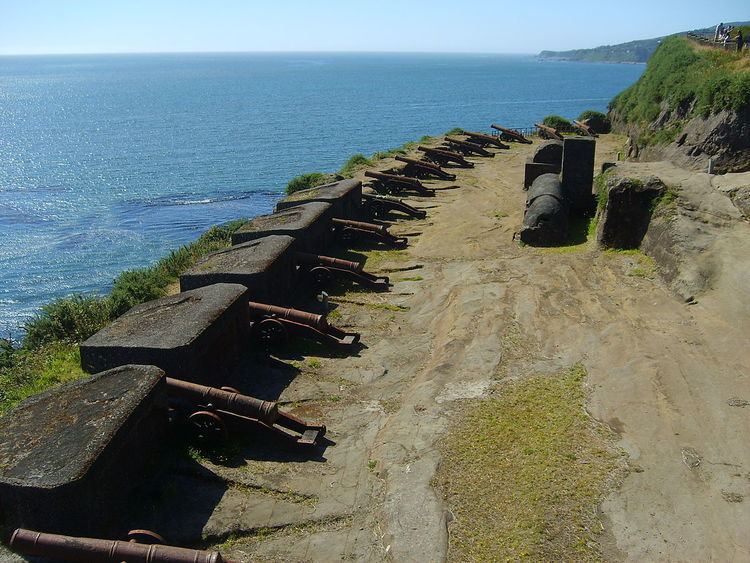 | ||
In Colonial times the Spanish Empire diverted significant resources to fortify the Chilean coast as consequence of Dutch and English raids. The Spanish attempts to block the entrance of foreign ships to the eastern Pacific failed due to the failure to settle the Strait of Magellan and the discovery of the Drake Passage. As result of this the Spanish settlement at Chiloé Archipelago became a centre from where the west coast of Patagonia was protected from foreign powers. In face of the international wars that involved the Spanish Empire in the second half of the 18th century the Crown was unable to protect peripheral colonies like Chile leading to local government and militias assuming the increased responsibilities.
Contents
Timeline of privateer and pirate activity
The following is a list of expedition and seafarers who landed or sailed in Chile with hostile intentions towards Spain or during times the country they served was at war with Spain.
As consequence of the Seven Years' War the Valdivian Fort System, a Spanish defensive complex in southern Chile, was updated and reinforced from 1764 onwards. Other vulnerable localities of colonial Chile such as Chiloé Archipelago, Concepción, Juan Fernández Islands and Valparaíso were also made ready for an eventual English attack.
With Spain and Great Britain at war again in the 1770s due to the American Revolutionary War local Spanish authorities in Chile received in 1779 the warning that a British fleet commanded by Edward Hughes was heading to Chilean coasts for an imminent attack. As concequence of this the Viceroyalty of Peru send economic aid to the garrisons at Valparaíso and Valdivia. The suspected attack did however never happen. In late 1788 suspicion of British attack rose appeared once again, this time stemming from observations of ships off the coast of Coquimbo. A defense plan where militias played a major role was hastly made up.
Preventing entry to the Pacific Ocean
In the 16th and 17th century Spain considered the Pacific Ocean a Mare clausum – a sea closed to other naval powers. As the only known entrance from the Atlantic the Strait of Magellan was at times patrolled by fleets sent to prevent entrance of non-Spanish ships. On the western end of the Pacific Ocean the Dutch threatened the Spanish Philippines. To end navigation by rival powers in the Strait of Magellan Spanish viceroy Francisco de Toledo ordered Pedro Sarmiento de Gamboa to explore the strait and found settlements on its shores.
Building fortifications
In Colonial times the Spanish Empire diverted significant resources to fortify the Chilean coast as consequence of Dutch and English raids. This was particularly true for the expensive Valdivian Fort System built after what would be the last Dutch incursion into Chile since Dutch rule in Brazil, from where the expedition to Chile was made, collapsed in 1645.
A Spanish fort in Taitao Peninsula was manned for one and half year beginning in 1750 before being abandoned.
Increased local participation in the defence
Spain's international wars at the second half of the 18th century evidenced the empire's difficulties in reinforcing its colonial possessions and provide them with economic aid. This led to an increased local participation in the financing of the defense and an increased participation in the militias by the Chilean-born. Such development was at odds with the ideals of the centralized absolute monarchy. The Spanish did also formal concessions to strengthen the defense: In Chiloé Spanish authorities promised freedom from the encomienda those indigenous locals who settled near the new stronghold of Ancud (founded in 1768) and contributed to its defense. The increased local organization of the defenses would ultimately undermine metropolitan authority and bolster the independence movement.
New roads
In the last decades of the 18th century the Spanish set out to build roads between strategic places in the coast. One such road, Caicumeo, connected the "city-fort" of Ancud with Castro. Another larger road came to connect Valdivia with the settlements at the northern shores of Chacao Channel providing this way a pathway for reciprocal military aid.
Patrolling western Patagonia
The Spanish failure at colonizing the Strait of Magellan made Chiloé Archipelago assume the role to protect the area of western Patagonia from foreign intrusions. In the aftermath of the wreckage of the HMS Wager (1741) in Guayaneco Archipelago a series of expeditions and patrolling was done in the coasts of Patagonia by the Spanish. A book based on the Wagner wreck published in 1748 in England exposed weaknesses of the Spanish rule in the Southeastern Pacific. This book together with rumors of a new British expedition made the Viceroy of Peru send expeditions to populate Juan Fernandez Islands, establish a fort in the island of Tenquehuén near Taitao Peninsula, and search for a frigate the British would supposedly have sent into the southeast Pacific.
